THIS: Artificial Intelligence Brief
By:
December 26, 2016
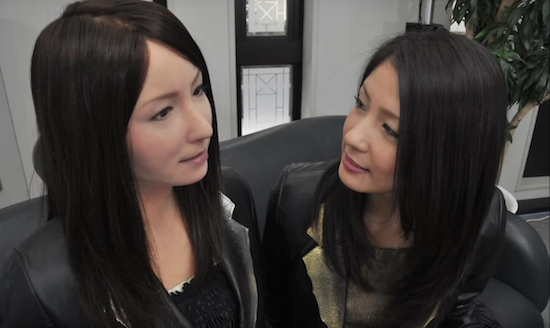
“Homo sapiens have outgrown their use,” sang Bowie before he was uploaded to the cosmic collective consciousness, but we make up an audience that synthetic intelligences may want to hold onto. The idea of variants on awareness (and perhaps, alternatives to mortality) is exercising a rare fascination on us at the current moment; the era of computer-composed Christmas carols, and boy-meets-algorithm stories like Her and Ex Machina, and both demonic and messianic machines like the Vision and the title-villain enacting the fight for our fate in Avengers: Age of Ultron, and weekly visits with higher intelligences in low places (HBO’s Westworld and ABC’s Agents of S.H.I.E.L.D.: LMD).
Ancient artforms and classic-model human beings are playing out these dramas of what makes us who we are (and how unique), in the DIY hip-hop transmedia franchise Brobot Johnson by Darian Dauchan (previously profiled here) and the stageplay The Adventures Of Minami: The Robot From Japan Who Makes You Feel Safe When Loneliness Is Palpable: Part 1 by Leah Nanako Winkler, which portrays the untested hazards of projecting our personalities onto circuits live and with the lowest of tech.
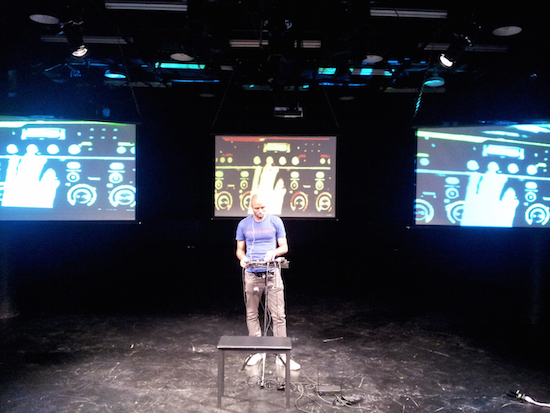
With all 13 episodes of the Brobot Johnson web series now up, the album out months ago and a stage version evolving in serial live workshops, I checked in with Dauchan to query what the future looks like now; we’ve avoided spoilers but certain characters and events we reference should make you go running to the full series right after reading this column, if not right now. The slapstick, sweet, surprisingly mournful and suddenly redemptive first season is more than you saw the sum of its ambitiously versatile parts coming together as.
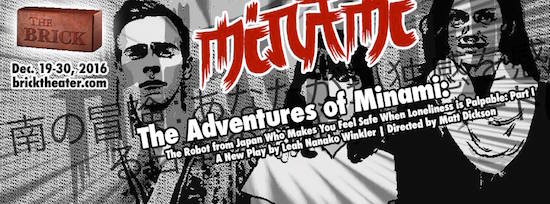
Minami, running through December 30 at Brooklyn’s theatre The Brick (and in an ongoing series of iterations of its own), is an undetached parallel strand of the present, being a hilarious, appalling, heartbreaking and thought-stimulating fantasia on the kinds of almost-convincing androids being designed by real-life roboticist Hiroshi Ishiguro (who’s also a character in the play). In Winkler’s scenario, the robot Minami, ostensibly an automated domestic (played with poignant perfection and eerie poise by Yurika Ohno), serves as the surrogate for a fraying married couple’s animosities and fading affections (artisanal suburban ickiness from Alex Herrald and Elizabeth Zephyrine McDonough), then as the shadow of a grieving young woman’s just-departed mother, whose clothes she wraps Minami in as she delivers her confessions of self-destructive despair after the 2016 election (an aria of despondent fury and compassionate fragility from Jahna Ferron-Smith). In the third act, Minami is back on the tradeshow/lecture-circuit pedestal, presented by Ishiguro (a fascinating shaded portrayal of need and remoteness, boyish wonder and driven gravitas by Ariel Estrada). He parades her enigmatic reactions to existential trick-questions in public, and then in private compares her uncontestably to a flesh-and-blood woman (fearless, volatile appetite and wisdom from Merissa Czyz), who expects a hookup with the great man, shifts to a philosophical argument about the senses versus the cerebral, and rages alone against her obsoleteness as Part 1 fades out.
The head and heart of Winkler’s own work display no contradiction or disconnect, and we spoke about how the components of her social imagination fit together (my talk with Dauchan follows right after):
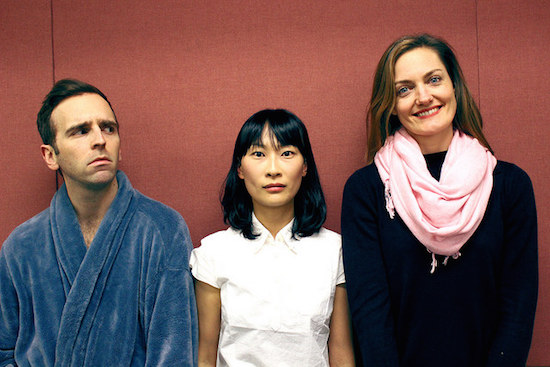
HILOBROW: It’s common to say that all fiction about other time periods (both future and past) is really about the present — is all fiction about creating life really about reverse-engineering ourselves?
WINKLER: Speaking only for myself, I think it’s easier to both digest as an audience member, and to cut to the core of as a writer, themes about the present in stories set in the past or future — in the same way that animation or Pixar movies can be extremely allegorical and political and yet still funny and accessible to the general audience. When you write about the present in the present, especially on huge topics like technology, humanity and politics, you run the risk of being perceived as preachy, pretentious or “too soon,” and I think people tend to appreciate the work way after you put it up. That always happens if someone is ahead of the curve or the first one to say something head-on. But if you give it a little bit of distance — whether that be in the time setting or the [genre] or with metaphors — you let yourself and the audience off the hook a little. Which can be good and bad. Good in the sense that looking at our ugliness and human gross behavior becomes a little easier to think about, but bad in the sense that people could miss the point entirely because it’s set in a “fictitious world,” which means you’re not held accountable. But, I will say that since Geminoid F (who Minami is highly based on) is a real robot, The Adventures Of Minami: The Robot From Japan Who Makes You Feel Safe When Loneliness Is Palpable: Part 1 is actually about the present world, aside from the fact that the specific android isn’t normalized in American culture. The three scenes presented at the Brick are all fiction, but because Minami’s model is one that actually exists, the situations presented, in my opinion, are highly possible if she were to get into our hands. Which is why the piece is funny. Truth is funny. There are a lot of humorous moments Matt Dickson (the director) and Yurika Ohno (Minami) found that stem from the real-life model not being too human-like yet. She breaks. She’s clearly not a person. Nobody thinks she is. She’s just this weird presence that sort of teeters between human and robot. I tried to stay as true-to-life as possible in Minami’s abilities, and most of the philosophies about robotics that Hiroshi Ishiguro talks about here are things he believes in real life. But in Part 2 I definitely plan to go into the future, so this notion is very useful!

HILOBROW: The role-switches are fascinating — Charles & Bethany’s repetitions and bizarre line-readings sound less fluent in humanity than Minami’s adaptations do, and Vanessa upends the cliché of the superficial groupie by being truly concerned with the inner workings of the human character while Hiroshi is fixated on its outer construction (which of course reverses gender stereotypes too)… are we always hiding what we claim we’re looking for?
WINKLER: I have a great team of actors who are extremely calibrated in honing in those points. I’m very fascinated by Merissa Czyz’s characterization of Vanessa as well. She does a great job reversing this gender stereotype in her performance and I love how she comes across at first as this “quirky” blonde chick but in a matter of eight minutes you realize she is extremely deep and weird and self-aware and unabashedly unafraid to get what she wants. But in her case, I don’t think what she thought she wanted (a hook-up with a world-renowned scientist) is actually what she wanted, for obvious reasons if you see the play. Which is a common thing that always happens, at least to me, when it comes to relationships and interactions with other humans where we are vulnerable. So, I don’t think we’re necessarily always hiding (though yes sometimes we do), but more often, we don’t exactly know what we’re looking for. Bethany and Charles think they’re looking for a renewal of their physical and emotional love, but really, without giving anything away, even after some of the physical stuff is restored by Minami, they still aren’t happy. And if you get what you want and you still aren’t happy, you could have bigger problems buried deep inside of yourself.
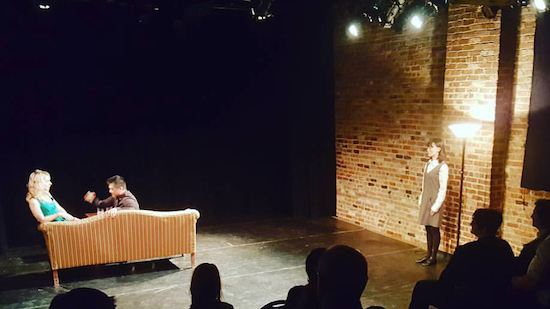
HILOBROW: Act 2 might be a rough draft of history but it is gloriously resolved drama. It reflects on the way the world we think we’re in changed with Trump’s election, so you must have just written it. But it fleshes out Minami’s nature and sketches in her story in essential ways. Was there some other chapter you planned to have placed there?
WINKLER: There was never another chapter that was supposed to go in its place. I’ve always wanted to explore the idea of a robot acting as a grief therapist, which is something Ishiguro has talked about in interviews. So I had written a version of that without the election playing a part in Rachel’s (Jahna Ferron-Smith) grief. But when Trump was elected I couldn’t not write about it and it ended up contributing to Rachel’s experience of loss. When everything seems to be going wrong, and another bad thing happens, how do you not let go? When you’re too vulnerable and broken to have the strength to seek help from a human being, how can technology help?
HILOBROW: Minami’s sequence of owners calls to mind real-life slave narratives set down for adults and abused-animal stories made up for kids. I’ve long thought that Asimov’s “The Bicentennial Man” was an archetypal slave narrative too, though perhaps with a bit less developed sense of injustice than your play. Are we doomed to history reiterating itself?
WINKLER: I really, really, really hope not.
HILOBROW: Projection is the curse of the dispossessed, and everyone makes of Minami what they please or need to. Will we see things from her viewpoint at some stage?
WINKLER: The next chapter will be very surprising. There’s a bit of foreshadowing in the play if you’re looking for it — when Ishiguro tells Vanessa, “And that’s when I realized that Minami is too beautiful to be human. How can androids exist as humans if they look better than humans? I must make the next Android look more like you….”
Minami’s current run continues through Dec. 30, 2016; information here.
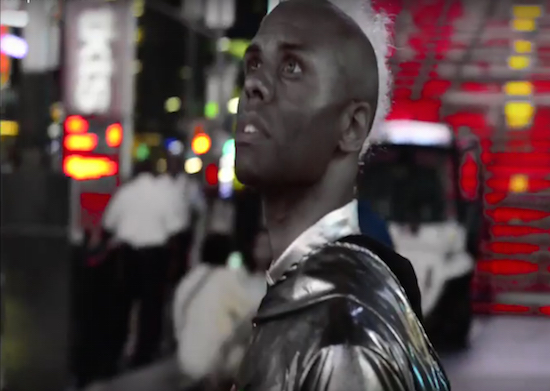
HILOBROW: Darian, there’s great comedy value in the different moods you affect as Brobot, but were you commenting on the artifice of humans themselves and questioning how much of our feelings are also a kind of costume?
DAUCHAN: There’s something interesting about this notion of “perfection,” and how do we attain it, how do we get better as human beings. This notion of correcting yourself and getting better through trial and error; there’s a lot of growth in that, and that is the beauty of existence. You make these mistakes but you evolve and adapt. We knew we were gonna have a lot of fun with that; Brobot making these mistakes and then mastering things.
HILOBROW: There are these few moments where it seems like Brobot is gaining his own perspective on something instead of just being programed to understand it — like when he grasps the beauty of a sunset or discerns from Sisbot’s suggestion that they are meant to be related and not romantic.
DAUCHAN: Definitely in the “Brobot Cry” episode you see him processing things in ways that start to lean toward emotional. That’s when we start to realize that whatever is in his DNA, there’s something that is very human, he’s connected to human traits. It’s interesting to see him bounce between those things. For Brobot to be able to have his own revelations is super important; it’s not just about the programming. There is an acceleration, like when we talk about the Singularity — once the wheels start spinning, everything accelerates.
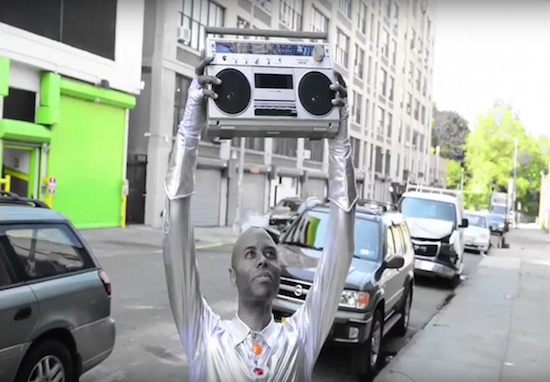
HILOBROW: Referring to Brobot’s “DNA” brought a curiosity to the surface about to what extent he’s mechanical, and how much he’s organic (as we understand those terms). Like the “robots” in R.U.R., who were actually genetically created.
DAUCHAN: We’ve been thinking about that a lot, and I’m not sure I have the answer. We do know that those lights [on his chest] glow and have something to do with him processing [laughs], but I’m not quite sure what’s underneath just yet. It’s interesting that you refer to cloning; it’s been interesting to edit the videos because it’s like [Brobot’s creator] Toussaint is watching over a younger version of himself.
HILOBROW: It’s pretty touching that, given the choice, Toussaint makes not a replica of his lost wife who could console him, but of a “son” who can go on without him.
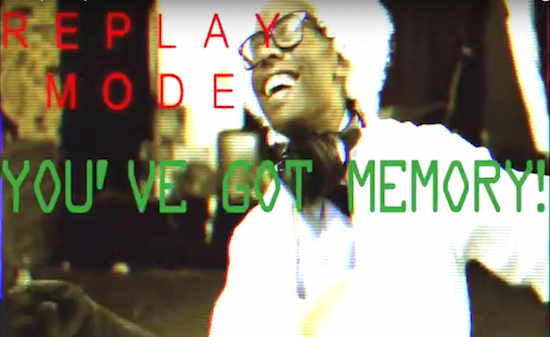
DAUCHAN: I’ve been thinking a lot about Toussaint’s whole timeline, how long he had invested his time and energy in this, and how devastating that tragedy must have been for him, that he immersed himself in his work, and finally achieves it but only has X amount of time to finish it. There’s still some things I can play with in terms of Toussaint’s journey; there still may be some cool ways, storywise, that I can go back and still have him in there… because I also have been thinking of having some villains who could show up later in the series, but conceivably be connected to Toussaint’s past.
HILOBROW: Rivals with a grudge against him, but who didn’t get to take it out on him…or someone who’s trying to outlaw Brobot.
DAUCHAN: It’s probably gonna be all of those things. I’ve created a Brobot “Bible” which explores what does it mean, politically and individually. For the initial [phases], what does it mean when there are Brobots and Sisbots, plural, a family of them, and how does the original Brobot figure out how to be a leader, to keep them together, and safe.
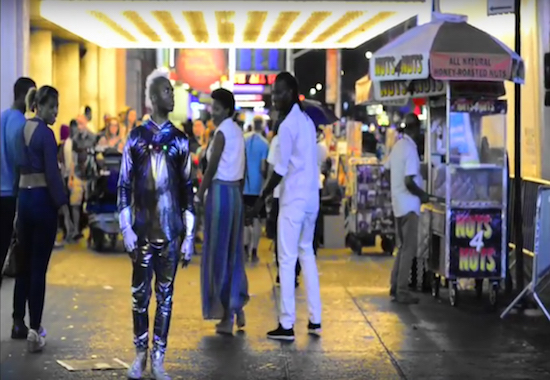
HILOBROW: It’s traditional in fiction to say that robots don’t have a “soul,” but Brobot seems to have less of a self, and that may not be such a bad thing.
DAUCHAN: It almost is the natural progression of evolution; I find that really interesting, and you start to realize that there aren’t a lot of series or shows that are designed around the robot; still very much a human being’s perspective of a robot. So there’s something interesting about continuing to explore what it means to have an advanced being… in the same way that you would with a superhero, where they’re the “other” but have the ability to do things that are elevated from what we can do.
HILOBROW: Though, one contrast between those two archetypes is that the superhero has “more” than us, while the robot is thought of as “missing” something we do have. These seem to scare us equally, though they’re kind of opposites.
DAUCHAN: It goes back to that whole “soulless” thing — what do they understand and what do they comprehend; it’s interesting that we’ve been fed that narrative a lot, that robots will be the end of us.
HILOBROW: The actor who plays Minami gives her a very believable, auto-tuned, beats-missing type of voice, which made me realize that we haven’t really heard Brobot speak as such; the narrator is omniscient and neither all storyteller nor all subject; the videos are like silent movies with the raps as soundtrack; and the workshop version of the stageshow I’ve seen has a distant descendant recounting Brobot’s story. Do you envision that we will ever hear Brobot and Sisbot speak, or will they always be framed in some way?
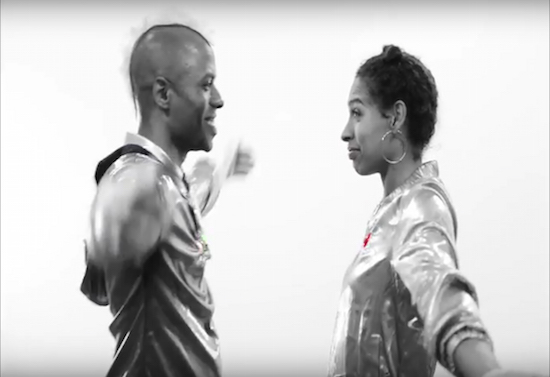
DAUCHAN: That’s rough, because that is a rule that I’ve established, and I really want to hang on to. It would be like Tom and Jerry or Wile E. Coyote talking, it breaks their whole thing! I’ve been thinking about that a lot, what it’s going to be — that somehow there is always hip-hop around them, lyrics that express their feelings [externally]. I haven’t solved it yet. There’s a Transformer whose radio speaks for him, it plays some soundbite and always kind of works for where he’s at…it might lean toward something like that. Because there is something awesome about never really quite hearing them speak; like the Blue Man Group, where you never hear them speak, but you always know where they’re at and where they stand. There’s something pure about it. But again, if it’s about communicating through hip-hop and beats, maybe there are these kind of MPC buttons that will allow them to communicate. Maybe the descendants are able to speak, but not the originals.
HILOBROW: We still do get a vivid sense of their subjectivity in this series, without hearing them recount it. Did you always feel this was a story that needed to unfold across many media — and maybe that all storytelling in this multi-sensory century needs to be done that way?
DAUCHAN: I was just excited by the opportunity to reach folks in a lot of different ways; it’s okay if someone never sees the [live] show, but they have the web series — I just got a comment today on Facebook, like, “Man, I love this series, big up from France”! A much as I love being a theatre artist, it’s also very ephemeral, it’s there and it’s gone; I just wanted to have a piece of art that could be accessible to a lot of different people. I want to continue to go in that direction in how I create art. The web series and the shows inform each other; we’re excited about seeing where it can go and who it can reach. Conceptually, there are opportunities for it to be some kind of comic book, which would open the base up even more. I’ve been interested in this notion of, is it possible to create your own independent franchise, and what does that look like? I’m trying to just be open to what feels like the best move, though the focus right now is on the [live] show. But beyond that, having written a kind of ten-page “mythology,” there are so many avenues that I could conceivably take it — though I’m not just gonna be able to do a videogame or film overnight.
HILOBROW: Do you foresee the stage show ever having more than one body onstage, as we see in the web series?
DAUCHAN: Since All for One is producing it, the sense is that it is a solo [work] — but, we are leaning far more towards it being as immersive as possible, meaning the “other bodies,” really, are the audience. So we’re thinking about making it so that maybe there are elements where the bulk of it is standing-room, where people are up on their feet and we are constantly doing stuff; there are chairs too for people who want that, but I think we really wanna get people up on their feet and dancin’ and groovin’, to make it an immersive experience. What I’ve been recently thinking about too is, if there’s a way to have it so that whatever we explore, there’s something that they are experiencing as well, meaning, everybody gets like, an almond for the “Brobot Eat” part [laughs], we can all do that together, or for the “Date” part there’s something like a rose petal, ways to keep everybody immersed in it in a really cool way. And again, all of this might get scrapped! It’s all a balancing act. We don’t want them to be totally lost, but, leave it to people’s imaginations a bit.
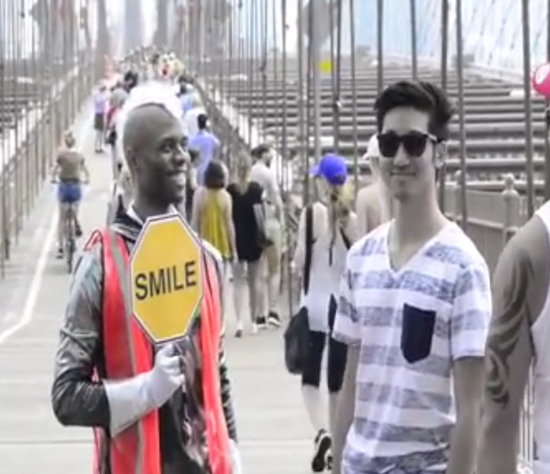
MORE POSTS by ADAM McGOVERN: OFF-TOPIC (2019–2025 monthly) | textshow (2018 quarterly) | PANEL ZERO (comics-related Q&As, 2018 monthly) | THIS: (2016–2017 weekly) | PEOPLE YOU MEET IN HELL, a 5-part series about characters in McGovern’s and Paolo Leandri’s comic Nightworld | Two IDORU JONES comics by McGovern and Paolo Leandri | BOWIEOLOGY: Celebrating 50 years of Bowie | ODD ABSURDUM: How Felix invented the 21st century self | CROM YOUR ENTHUSIASM: C.L. Moore’s JIREL OF JOIRY stories | KERN YOUR ENTHUSIASM: Data 70 | HERC YOUR ENTHUSIASM: “Freedom” | KIRK YOUR ENTHUSIASM: Captain Camelot | KIRB YOUR ENTHUSIASM: Full Fathom Five | A 5-part series on Jack Kirby’s Fourth World mythos | Reviews of Annie Nocenti’s comics Katana, Catwoman, Klarion, and Green Arrow | The curated series FANCHILD | To see all of Adam’s posts, including HiLo Hero items on Lilli Carré, Judy Garland, Wally Wood, and others: CLICK HERE
